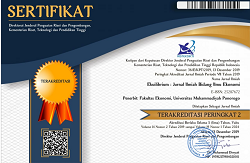Causal Relations Between Knowledge, Norms, and Tax: A Study of Gender Differences on Taxpayers
DOI: 10.24269/ekuilibrium.v15i1.2020.pp14-26
Abstract
This research analyzes whether tax knowledge and social norms positively influence tax compliance and whether gender differences will moderate their relation. A web-based survey used to spread questionnaires to 145 taxpayers that domiciled in Cikarang. The results revealed that tax knowledge significantly affects tax compliance, but there are no gender differences between tax knowledge and tax compliance. In contrast, social norms positively affect tax compliance, and gender differences also exist between social norms and tax compliance. As there are no gender differences in tax knowledge and tax compliance, socialization can be done with the same approach towards both males and females. However, gender differences in social norms lead to a difference between males and females in their point of view regarding tax. As most of the female internalized norms more than males, therefore a group with the majority of females more efficient in socialization. On the other hand, providing detail information and fact in socialization is more suitable for a male.
Keywords
Tax knowledge, Social norms, Tax compliance, Gender, Taxpayer
References
- Amponsah, S. & Adu, K.O., 2017, “Socio-demographics of tax stamp compliance in upper Denkyira east municipal and upper Denkyira west district in Ghana”. International Journal of Law and Management, 59(6), 1315-1330.
- Anselmi, D. L., & Law, A. L., 1998, Questions of gender: Perspectives and paradoxes. McGraw-Hill Humanities, Social Sciences & World Languages.
- Blanthorne, C., & Kaplan, S., 2008, “An egocentric model of the relations among the opportunity to underreport, social norms, ethical beliefs, and underreporting behavior”, Accounting, Organizations, and Society, 33(7), 684-703.
- Bobek, D. D., Hageman, A. M., & Kelliher, C. F, 2011, “The social norms of tax compliance: Scale development, social desirability, and presentation effects”, Advances in Accounting Behavioral Research (pp. 37-66). Emerald Group Publishing Limited.
- Bobek, D. D., Hageman, A. M., & Kelliher, C. F., 2013, “Analyzing the role of social norms in tax compliance behavior”, Journal of Business Ethics, 115(3), 451-468.
- Bobek, D. D., Roberts, R. W., & Sweeney, J. T., 2007, “The social norms of tax compliance: Evidence from Australia, Singapore, and the United States”, Journal of Business Ethics, 74(1), 49-64.
- Bornman, M. & Ramutumbu, P., 2019, “A conceptual framework of tax knowledge”. Meditari Accountancy Research, 27(6), 823-839.
- Chan, C. W., Troutman, C. S., & O’Bryan, D, 2000, “An expanded model of taxpayer compliance: Empirical evidence from the United States and Hong Kong”, Journal of International Accounting, Auditing, and Taxation, 9(2), 83-103.
- Chau, G., & Leung, P., 2009, “A critical review of Fischer tax compliance model: A research synthesis”, Journal of Accounting and Taxation, 1(2), 34-40.
- Chung, J., & Trivedi, V. U., 2003, “The effect of friendly persuasion and gender on tax compliance behavior”. Journal of Business Ethics, 47(2), 133-145.
- Cialdini, R. B., & Trost, M. R, 1998, “Social influence: Social norms, conformity, and compliance. In D. T. Gilbert, S. T. Fiske. & G. Lindzey (Eds.)”. The Handbook of Social Psychology (pp. 151 – 192). New York, NY, US: McGraw-Hill.
- D’Attoma, J., Volintiru, C. & Steinmo, S., 2017, “Willing to share? Tax compliance and gender in Europe and America”, Research and Politics, 4(2), 1-10.
- Dillman, D. A., 2000, Mail and Internet Survey: The Tailored Design Method, Second Edition, John Wiley and Sons., New York
- Directorate General of Taxation. 2019, February 20, “Kompleksitas Kepatuhan Pajak”, Direktorat Jenderal Pajak Kementrian Keuangan, Retrieved from http://www.pajak.go.id/.
- Directorate General of Taxation. 2019, January 15. “Pajak Sebagau Ujung Tombak Pembangunan”, Direktorat Jenderal Pajak Kementrian Keuangan, Retrieved from http://www.pajak.go.id/.
- Eriksen, K., & Fallan, L., 1996, “Tax knowledge and attitudes towards taxation; A report on a quasi-experiment”, Journal of Economic Psychology, 17(3), 387-402.
- Fallan, L., 1999, “Gender, exposure to tax knowledge, and attitudes towards taxation: An experimental approach”, Journal of Business Ethics, 18(2), 173-184.
- Fischer, C. M., Wartick, M., & Mark, M. M., 1992, “Detection probability and taxpayer compliance: A review of the literature”, Journal of Accounting Literature, 11, 1 - 46.
- Fornell, C., & Larcker, D. F., 1981, “Evaluating structural equation models with unobservable variables and measurement error”, Journal of Marketing Research, 18(1), 39-50.
- Hair, J. F., Black, W.C., Barry, J. B., & Anderson, R.E., 2010, Multivariate Data Analysis (7th ed.). Pearson Education International.
- Hair, J. F., Hult, G. T., Ringle, C., and Sarstedt, M., 2013, A Primer on Partial Least Squares Structural Equation Modeling (PLS-SEM), SAGE Publications.
- Houston, J., & Tran, A., 2001, “A survey of tax evasion using the randomized response technique”, Advances in Taxation, 69-94.
- Investopedia. (n.d.). Retrieved from https://www.investopedia.com/terms/t/taxes.asp.
- Jimenez, P., & Iyer, G. S., 2016, “Tax compliance in a social setting: The influence of social norms, trust in government, and perceived fairness on taxpayer compliance”, Advances in Accounting, 34, 17-26.
- Jackson, B. R., & Milliron, V. C., 1986, “Tax compliance research: Findings, problems, and prospects”, Journal of Accounting Literature, 5(1), 125-165.
- Kasipillai, J., & Abdul-Jabbar, H., 2006, “Gender and ethnicity differences in tax compliance”, Asian Academy of Management Journal, 11(2), 73-88.
- Kastlunger, B., Dressler, S. G., Kirchler, E., Mittone, L., & Voracek, M., 2010, “Sex differences in tax compliance: Differentiating between demographic sex, gender-role orientation, and prenatal masculinization (2D: 4D)”, Journal of Economic Psychology, 31(4), 542-552.
- Kemenkeu, 2016, October 21, “Menkeu Nilai Tingkat Kepatuhan Wajib Pajak Indonesia Masih Rendah” Kementrian Keuangan Republik Indonesia. Retrieved from https://www.kemenkeu.go.id/.
- Kirchler, E., & Wahl, I., 2010, “Tax compliance inventory TAX-I: Designing an inventory for surveys of tax compliance”. Journal of Economic Psychology, 31(3), 331-346.
- Kichcher, E., & Maiejovsky, B., 2001, “Tax compliance within the context gain and loss situation expected and current asset position, and professional”, Journal of Economic Psychology, 22(2), 173-194.
- Kirchler, E., Niemirowski, A. & Wearing, A., 2006, “Shared subjective views, intent to cooperate and tax compliance: Similarities between Australian taxpayers and tax officers”, Journal of Economic Psychology, 27(4), 502-517.
- Kock, N., 2014, “Advanced mediating effects tests, multi-group analyses, and measurement model assessments in PLS-based SEM”, International Journal of e-Collaboration, 10(1), 1-13.
- Loo, E. C., 2006, “Tax knowledge, tax structure, and compliance: A report on a quasi-experiment”, New Zealand Journal of Taxation Law and Policy, 12(2), 117-140.
- Lohse, T. & Qari, S., 2014, “Gender differences in deception behavior: The role of the counterpart”, Applied Economics Letters, 21(10), 702-705.
- Tan, L. M., & Chin-Fatt, C., 2000, “The impact of tax knowledge on the perceptions of tax fairness and attitudes towards compliance”, Asian Review of Accounting, 8(1), 44-58.
- Nunnally, J. C., 1978, Psychometric Theory. 2nd eds. (McGraw-Hill, NY).
- Richardson, G., 2006, “Determinants of tax evasion: A cross-country investigation”, Journal of International Accounting, Auditing, and Taxation, 15(2), 150-169.
- Roth, J. A., & Scholz, J. T., 1989, Taxpayer Compliance, Volume 1: An Agenda for Research (Vol. 1). University of Pennsylvania Press.
- Saad, N, 2010, “Fairness perceptions and compliance behavior: The case of salaried taxpayers in Malaysia after implementation of the self-assessment system”, E-Journal of Tax Research, 8(1), 32-63.
- Saad, N., 2014, “Tax knowledge, tax complexity, and tax compliance: Taxpayers' view”, Procedia-Social and Behavioral Sciences, 109, 1069-1075.
- Sri Mulyani: Tax Ratio Indonesia Terendah, (2017, January 10), Retrieved from https://www.wartaekonomi.co.id/.
- Venkatesh, V., & Morris, M. G, 2000, “Why don't men ever stop to ask for directions? Gender, social influence, and their role in technology acceptance and usage behavior”, MIS Quarterly, 115-139.
- Wenzel, M., 2004, “An analysis of norm processes in tax compliance”, Journal of Economic Psychology, 25(2), 213-228.
- Wenzel, M., 2005, “Motivation or rationalization? Causal relations between ethics, norms, and tax compliance”, Journal of Economic Psychology, 26(4), 491-508.
Refbacks
- There are currently no refbacks.

This work is licensed under a Creative Commons Attribution-ShareAlike 4.0 International License.














